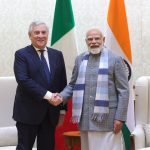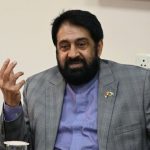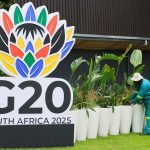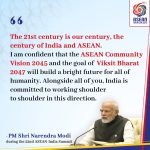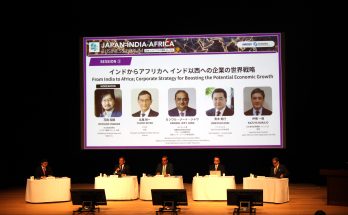It’s time for Afro-optimism in India, and it is crystallised in the ongoing third India-Africa Forum Summit, the biggest diplomatic show India has hosted in over three decades. The narrative of a resurgent continent is intersecting with that of a rising India, opening up new vistas for reinvigorating a critical partnership between the two growth hubs of the rejuvenated global South.
Intwined Resurgence
Refreshingly, gloom-and-doom narratives of Africa that coloured portrayals of Africa are becoming increasingly passé. Resurgence, Renewal and Renaissance are the new buzzwords, with some of the fastest growing economies located in Sub-Saharan Africa. Tired of being trapped in stale clichés – what Nigerian writer Chimamanda Ngozi Adichie has called “the single story on Africa, the single story of catastrophe” — more than 30 countries are now functional democracies, many African countries have launched path-breaking reforms, the size of the middle class has gone up to over 300 million, making Africa the market of the future.
The success stories of Africa are multiplying by the day: to give some random examples, Rwanda outstrips India in ease of doing business index, mobile transfer of money is becoming a norm in many African countries and new innovative apps are being developed by creative talents of this continent, which is described in a formulaic fashion as resource-rich, but should be more appositely labelled as people-rich, with 65 per cent of population below 35. Similarly, although the road ahead is fraught with challenges, the story of ‘India Unbound’ is gaining greater traction, with upbeat projections for one of the world’s fastest growing economies. This intertwined resurgence of India and Africa forms the larger backdrop of the IAFS-III, making it a unique historical moment to build on “shared vision” for a “reinvigorated partnership,” – as the motto of the third summit says with an evocative logo of the conjoined Indian lion and African lion.
Elephant and Dragon
In many ways, Prime Minister Narendra Modi is uniquely poised to give the much-needed ballast to this multi-faceted partnership because it was from Gujarat that the trading connections started with the eastern seaboard of Africa. The successful Gujarati diaspora in east African countries is an eloquent reminder of those early days of forging economic links which is now blossoming into a full-blooded economic relationship, with bilateral trade surging to $70 billion and Indian investments increasing to $30-35 billion. But while India has scored some successes in the economic realm as well as in its development partnership with the continent, it’s hard to escape comparisons in the fiercely competitive world.
In media and academic discourse, the new cliché is India playing catch-up with China in Africa, but such constructions are odious and misleading as the engagement of New Delhi and Beijing with the continent has evolved on different trajectories. True, China’s trade with Africa, at &210 billion, is at least three times more than that of India’s bilateral trade with the continent. China has also emerged as a big player in Africa’s infrastructure sector and forged interlocking relationships with the power elite of the continent. But China’s success in Africa has also its flip side: the Chinese activities are coming under the scanner in Africa, with many questioning the Chinese practice of bringing its own labour to work on projects in African countries and flooding many African countries with cheap Chinese goods, destroying local industries in the process.
The West, which has felt threatened with China’s upward graph in Africa, has been also pushing the construct of China as a neo-colonial power, which has resonance in some African countries. This has spawned a new discourse of a neo-scramble for Africa, but the point with these formulations is that they assume Africa as a chessboard on which such power games are to be played out. This is clearly a neo-colonial prism, and India has done the right thing by shunning it, by refusing to be part of any race or competition, but has insisted on an equal partnership and a template of mutual resurgence underpinned by trinity of 3Ts: Trade, Training and Technology. In this context, it is important to remember that the continent does not look at India and China as rivals as it needs both Asian powers as well as other emerging powers to nourish its resurgence.
Triple S mantra
In another context, speaking about the China challenge, Prime Minister Modi enunciated the ‘Triple S’ mantra – Skill, Scale and Speed – and this could well be the new template for upscaling India-Africa relations across the spectrum in the 21st century. This triple S mantra is not designed to compete with or counter China in Africa, but to spur the flowering of over two billion people living in the two youngest regions of the world.
Skill: Capacity building, training and nurturing of Africa’s most precious resource – over a billion people of the continent – are key features of India’s burgeoning developmental cooperation with the African continent. The ITEC exemplifies the transformative power of knowledge-sharing, with 25,000 students offered scholarships over the last few years. The pan-Africa e-network, which seeks to bridge the digital divide and bring telemedicine and tele-education to the people of Africa, has emerged as a symbol of innovation-driven thinking in India’s outreach to Africa. The decision to set up around 100 training institutes encompassing a wide spectrum of areas promises to be a game-changer in aiding Africa’s drive to create a critical mass of skilled and empowered people which will be an engine of the continent’s growth in years to come. In years to come, this focus on skill-building and human resource development in Africa’s policy should gain an added traction as it holds the key to sustain the ongoing African resurgence. Looking ahead, India should raise the bar and be proactively involved in crafting new e-network like projects and IIT-IIM-like institutions in Africa.
Scale: India’s developmental and economic partnership with Africa is broadly on track, but it’s time to get more ambitious, think big and flesh out a bigger canvas of India-Africa strategic partnership in the 21st century. PM Modi has done the right thing by putting on hold the Banjul formula and inviting the leaders and representatives of all 54 African countries to accelerate across-the-board relations with the continent. The key outcomes of the summit – the likely announcement of around $10 billion in new Lines of Credit, setting up of a dedicated Africa Fund, the vision document on joint development of blue economy – are going to reflect this emphasis on scale. But with a rising continent, the sky is also not the limit. Talking of scale, it’s important to take two concrete steps in the near term: 1) To scale up India’s diplomatic representation in Africa by setting up new embassies and missions. Currently, India has only around 30 embassies, with an Indian ambassador often co-accredited to 3-4 African countries. China has embassies/missions in African countries II) Bridging diplomatic deficit by frequent visits by the top leadership, including the prime minister, president, vice-president and foreign minister. In diplomacy, optics are important and high-profile visits bring the relationship under the public spotlight. In this context, the record is dismal. Manmohan Singh visited only two countries – Nigeria and South Africa – for standalone bilateral visits during his ten-year prime ministerial tenure. PM Modi has yet to find time to visit Africa, but if the buzz is anything to go by, he plans to make up for it by going on a multi-nation tour to Africa next year.
Speed: In today’s wired world, speed holds the essence to success. PM Modi has shown a flair for speed by travelling to dozens of countries in the first eighteen months of his tenure, and unveiling a new style of diplomacy. The optics and declarations must now be backed by speedy delivery of aid and projects promised to Africa. Over the last two summits, India promised around 100 training institutes, but only 40 have taken off the ground. True, these projects are built on a co-ownership model and the gestation period is long, but looking ahead, the focus should be to make only those promises which can be delivered on time. The IAFS-III is expected to incorporate this mantra of speed as a new mechanism is expected to be firmed up for fast-tracking these training institutes.
The Road Ahead: Three Cs
Armed with this ‘Triple S’ mantra, the India-Africa partnership can zoom onto a higher trajectory, both qualitatively and quantitatively, but this template will be incomplete and lacking the much-needed resonance if people-to-people connect is not positioned at the heart of this burgeoning relationship. Currently, clichés clutter communication and there is a forbidding information and knowledge deficit between the people of India and Africa.
The road to better mutual understanding lies through the 3C bridge – Communication, Culture and Creativity. The stories of India and Africa, and of the India-Africa partnership, need to be told more eloquently and passionately, sans stereotypes, by taking into account mind-boggling diversities of these emerging societies and their attendant angularities. Until lions write their own history, as an African proverb says, the tale of the hunt will always glorify the hunter. Moving beyond the metaphors of the hunter and hunted, it’s time to focus on creating new narratives, and change the way we speak about each other.
Manish Chand is Editor-in-Chief of India Writes Network, www.indiawrites.org, an e-magazine-journal focused on international affairs, emerging powers and Africa. He has edited Africa Quarterly and “Two Billion Dreams: Celebrating India-Africa Friendship,” a book capturing myriad facets of the burgeoning India-Africa relationship. He has co-edited “Engaging with a Resurgent Africa (McMillan),” and India-Africa Partnership: Towards Sustainable Development (RIS).
Author Profile

- Manish Chand is Founder and Editor-in-Chief of India Writes Network (www.indiawrites.org) and India and World, a pioneering magazine focused on international affairs. He is CEO, Centre for Global India Insights, an India-based think tank focused on global affairs.
Latest entries
 India and the WorldDecember 12, 2025India-Italy bonding: Tajani’s visit raises the bar for business, maritime ties
India and the WorldDecember 12, 2025India-Italy bonding: Tajani’s visit raises the bar for business, maritime ties In ConversationNovember 26, 2025G20 is a Force for global Good
In ConversationNovember 26, 2025G20 is a Force for global Good articlesNovember 26, 2025Rescuing G20 from North-South divide: Ubuntu Moment
articlesNovember 26, 2025Rescuing G20 from North-South divide: Ubuntu Moment India and the WorldOctober 27, 2025Modi hails the century of India and ASEAN, backs ASEAN centrality
India and the WorldOctober 27, 2025Modi hails the century of India and ASEAN, backs ASEAN centrality





